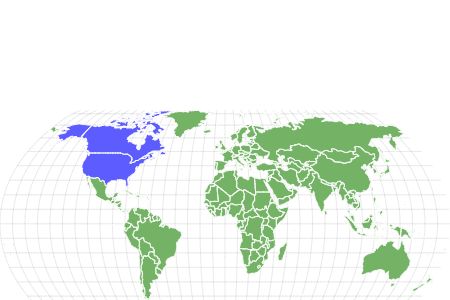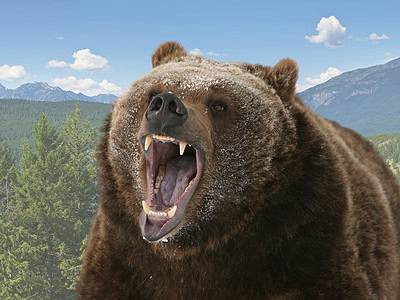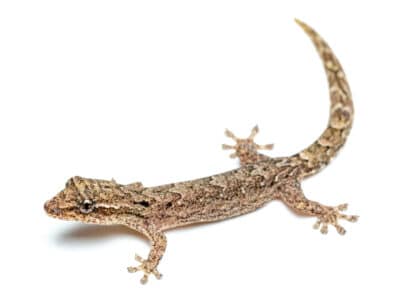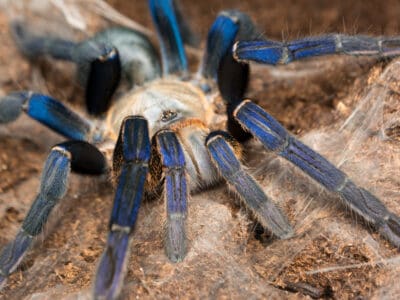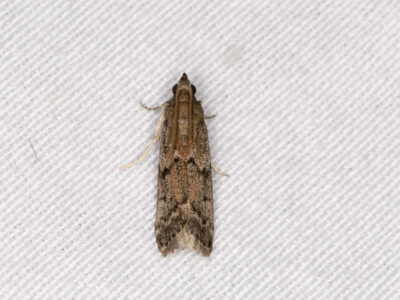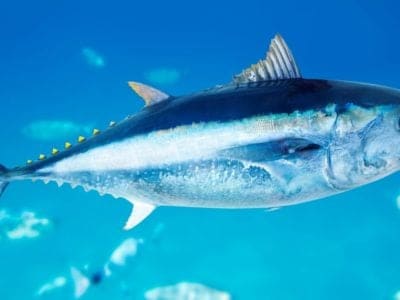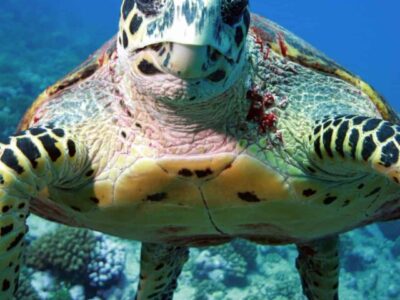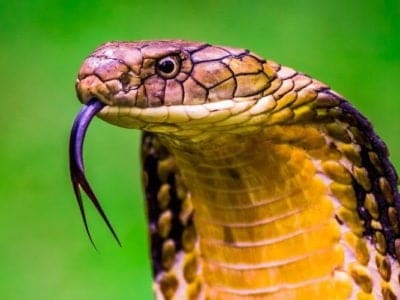Eastern Hognose Snake
Heterodon platirhinos
Eastern hognose snakes are venomous, but only to frogs and toads.
Advertisement
Eastern Hognose Snake Scientific Classification
- Kingdom
- Animalia
- Phylum
- Chordata
- Class
- Reptilia
- Order
- Squamata
- Family
- Colubridae
- Genus
- Heterodon
- Scientific Name
- Heterodon platirhinos
Read our Complete Guide to Classification of Animals.
Eastern Hognose Snake Conservation Status
Eastern Hognose Snake Facts
- Prey
- Frogs, lizards, toads, rodents
- Main Prey
- Toads
- Name Of Young
- hatchling
- Group Behavior
- Solitary
- Solitary except during mating season
- Communal Dens
- Fun Fact
- Eastern hognose snakes are venomous, but only to frogs and toads.
- Biggest Threat
- Habitat destruction
- Most Distinctive Feature
- Upturned scale on the snout
- Other Name(s)
- spreading adder, spread'em outer, adder, bastard rattlesnake, black adder, black blowing viper, black hog-nosed snake, black viper snake, blauser, blowing adder, blow snake, buckwheat-nose snake, calico snake, checkered adder, chunk head, common hog-nosed snake, common spreading adder, deaf adder, eastern hognose snake, flat-head, flat-head adder, hay-nose snake, hissing adder, hissing snake, hog-nosed adder, hog-nosed rattler, hog-nose snake, hog-nosed viper, hissing viper, (mountain) moccasin, North American adder, North American hog-nosed snake, pilot, poison viper, puff(ing) adder, red snake, rock adder, rossel bastard, sand adder, sand viper, spotted (spreading) adder, spread nelly, spread-head moccasin, spread-head snake, spread-head viper, flat-head adder viper
- Gestation Period
- 2 months
- Lifestyle
- Crepuscular
- or Nocturnal Depending on Region and Season
- Favorite Food
- Toads
- Common Name
- Eastern hognose snake
- Location
- Eastern United States and southern Ontrario, Canada
- Average Clutch Size
- 25
- Nesting Location
- Sand, loose soil, rotten wood
Eastern Hognose Snake Physical Characteristics
- Color
- Brown
- Grey
- Yellow
- Red
- Black
- Tan
- Green
- Dark Brown
- Cream
- Skin Type
- Scales
- Lifespan
- 12-18 years
- Length
- 24-33 inches
- Age of Sexual Maturity
- 2-3 years
- Venomous
- Yes
- Aggression
- Low
View all of the Eastern Hognose Snake images!
Eastern hognose snakes eat toads and frogs and are immune to the skin toxins toads excrete.
The eastern hognose is a small, mildly venomous snake native to southern Ontario, Canada, and the eastern United States. Its threat displays are antics that everyone should witness at least once in their life.
Incredible Eastern Hognose Facts
- Their defensive displays include playing dead, and that’s after pretending to be a cobra, hissing, and defecating on you.
- Their nose has an upturned scale that helps them burrow through the sand.
- The eastern hognose is the most widespread hognose species.
Eastern Hognose Scientific Name and Classification
Hognose snakes are members of the very large Colubridae family of snakes. This family has everything from nonvenomous king snakes and indigo snakes to highly venomous twig snakes and boomslang.
The eastern hognose snake’s scientific name is Heterodon platirhinos. Heterodon is Greek and means “different tooth;” it refers to unusually large teeth in the back of their mouths that they use to deflate toads for easier swallowing. “Platirhinos” means flat snout and refers to the upturned scale at the end of their nose.
Eastern hognose snakes are often called drama queen, drama noodle, hiss adder, false cobra, spreading adder, blow viper, hissing sand snake, and a variety of other descriptive names. They all refer to some aspect of their very innovative defensive behavior.
There are four species of hognose snakes in the Heterodon genus. They include the Eastern hognose snake (H. platirhinos), Western or Plains hognose snake (H. nasicus), Mexican hognose snake (H. kennerlyi), Southern hognose snake (H. simus)
Eastern Hognose Appearance
Their colors and patterns are highly variable. In one area, eastern hognoses can be nearly black; in others, they may be tan with brown and dark brown blotches everywhere. Eastern hognose snakes have a base color of red, tan, brown, or gray, overlayed with darker blotches and keeled scales. Their belly is usually solid gray, yellow, or cream-colored.
These snakes are small and often don’t exceed 28 inches in total length; however, the longest recorded eastern hognose snake was 46 inches. The females are usually larger than the males.
This species has an adorable expression that’s created by their flattened, upturned snout and medium-sized eyes. Two bars usually extend across the top of their head, and they have diagonal stripes that start behind their eyes. They have dark eyes, their head isn’t easy to distinguish from their neck, and their tail markings become rings or bands toward the end.
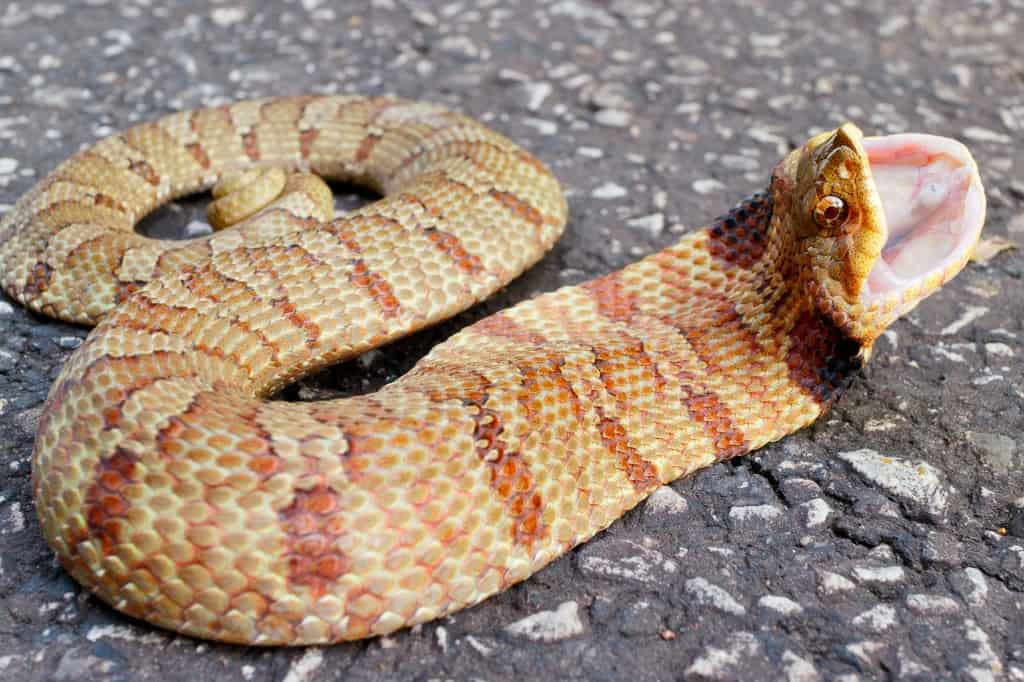
Hognose snakes are known for their extreme defensive tactics.
©iStock.com/Rex Lisman
Eastern Hognose Behavior
These shy snakes are widespread but not often seen. They spend most of their time in leaf piles or loose soil, rooting around for toads.
Eastern hognose snakes aren’t very big or intimidating, so they do their best with what they have. This snake is known for its highly animated and extremely entertaining defensive display. Most of its common names are directly related to some aspect of it. When threatened, it begins by spreading out its neck in a mock-cobra attempt and strikes at the threat with its mouth closed. Sort of like a high-speed head butt. This snake will never see a cobra and doesn’t live anywhere near them; however, this is an attempt to look bigger and more dangerous to a predator.
If the cobra act doesn’t work, then it takes the action to the next level. The snake then writhes around with its tongue hanging out, until it comes to a stop, belly up. During this whole ordeal, it often defecates on itself. If you pick it up and turn it over, so the belly is down, the eastern hognose will often turn itself right back over again. It will continue to do this for several minutes until after the threat is gone. A few have kept up the act for as long as 45 minutes.
Eastern Hognose Habitat and Diet
Eastern hognose snakes have the most extensive range of any hognose species. It covers most of the eastern United States and the far southern bit of Ontario, Canada.
These snakes tend to prefer sandy pine forests, old fields, and forest edges. They especially like dry areas with loose soil that they can burrow into. This snake uses those for nesting and laying its eggs. In the far northern reaches of their range, they prefer developed fields and mixed forests. A Canadian study indicated that the average home range of an Eastern hognose snake is about 98 acres (40 hectares).
This species specializes in eating toads and sometimes frogs. Captive-bred individuals can usually be taught to take pinky mice. However, small rodents aren’t typically part of their diet, so wild-caught individuals often die in captivity because keepers can’t meet the dietary needs of the snake.
Eastern Hognose Predators, Threats, Conservation, and Population
These small snakes have a number of predators – foxes, hawks, larger snakes, and more.
According to the IUCN Redlist of Threatened Species, eastern hognose snakes are classified as a species of Least Concern. They’re widespread and fairly common throughout most of its range. However, in Ontario, Canada and northeastern U.S. states such as Connecticut, New Hampshire, New York, and Rhode Island it’s under increasing pressure and is protected in those areas.
No one is completely certain about the reason for their population decline. However, habitat loss and fragmentation, road mortality, and intentional killing seem to be the primary causes.
Eastern Hognose Venom
For many years, these snakes were considered nonvenomous because they’re not dangerous to people. However, hognose snakes do have a mild, amphibian-specific venom that they use to subdue the toads they eat. Their enlarged rear teeth inject venom that’s stored in the snake’s Duvernoy’s gland. People who have been bitten have noticed local swelling if they were allergic, but there haven’t been any deaths recorded because of this species.
Eastern Hognose Reproduction, Babies, and Lifespan
Eastern hognose snakes generally live up to 12 years in the wild, but they can live to about 18 if they’re well-cared for in captivity. This species breeds when snakes come out of brumation in March or April. The females lay 8-40 eggs that incubate for about 60 days. Some females have been seen bypassing great nesting areas in favor of a communal nest. They don’t incubate their eggs; and the babies measure about 5-12 inches long and are on their own from the moment they hatch.
Next Up
- Great plains rat snake is sometimes mistaken for hognose snakes, but these snakes spend more time finding themselves in interesting predicaments.
- Coachwhip these snakes are named because the markings towards the end of their body look like the braided end of a whip.
- Indigo snakes are some of the longest snakes in North America.
Eastern Hognose Snake FAQs (Frequently Asked Questions)
What happens if an eastern hognose snake bites you?
Not much, really. While they are mildly venomous, their venom is specifically designed for their favorite prey – toads. A bite from one of these little guys shouldn’t do much. If you’re allergic to the venom, you may have a bigger reaction – itching and swelling – but there aren’t any records of severe problems or death.
Are eastern hognose snakes aggressive?
No, they’re a flight vs flight kind of snake. Barring escape, they go through a very well-planned and precise series of actions designed to frighten and disgust a predator.
Where do eastern hognose snakes live?
These snakes inhabit most of the eastern United States and a small portion of southern Ontario, Canada.
What do eastern hognose snakes eat?
Mainly, they eat toads and frogs. They’ll also eat lizards and small rodents if they must.
Why do people call them drama noodles?
It’s because their defensive tactics are the best form of drama! They’re entertaining every time, and some of them are very dedicated to their playing dead act.
Thank you for reading! Have some feedback for us? Contact the AZ Animals editorial team.
Sources
- Hammerson, G.A. 2007. Heterodon platirhinos. The IUCN Red List of Threatened Species 2007: e.T63820A12718733. https://dx.doi.org/10.2305/IUCN.UK.2007.RLTS.T63820A12718733.en. / Published March 1, 2007 / Accessed August 8, 2022
- Robson, Laura Elizabeth, The spatial ecology of Eastern Hognose Snakes (Heterodon platirhinos): habitat selection, home range size, and the effect of roads on movement patterns. / Published January 1, 2011 / Accessed August 8, 2022
- Young, Robert A., Effects of Duvernoy's gland secretions from the eastern hognose snake, Heterodon platirhinos, on smooth muscle and neuromuscular junction / Published July 1, 1992 / Accessed August 8, 2022
- Heterodon platirhinos | Reptarium Reptile Database / Accessed August 8, 2022

